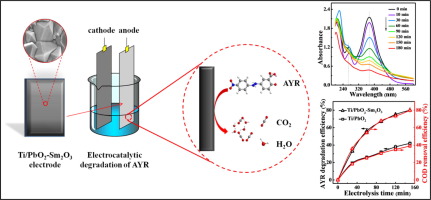Journal of Colloid and Interface Science ( IF 9.4 ) Pub Date : 2018-09-04 , DOI: 10.1016/j.jcis.2018.09.003 Ying Zhang , Ping He , Lingpu Jia , Caixia Li , Huanhuan Liu , Shuai Wang , Shiping Zhou , Faqin Dong

|
In this work, a novel Ti/PbO2-Sm2O3 composite electrode with high electrocatalytic activity is successfully fabricated via simple electrodeposition method and further investigated for electrochemical degradation of alizarin yellow R (AYR) wastewater. The test results of X-ray diffraction, field-emission scanning electron microscopy and energy-dispersive X-ray spectroscopy confirm that Sm2O3 is successfully composited with PbO2. The coating of Ti/PbO2-Sm2O3 composite electrode stacked by typical pyramid-like micro-particles exhibits smooth and compact surface morphology which is conducive to enhancing the corrosion resistance of electrode. Furthermore, electrochemical performance tests indicate that Ti/PbO2-Sm2O3 composite electrode has advantages of higher oxygen evolution potential, lower charge transfer resistance and longer lifetime over Ti/PbO2 electrode. Electrolyte concentration, plate space, initial pH and cell voltage are assessed to optimize the degradation condition of AYR. The results show that COD removal efficiency and degradation efficiency of AYR on Ti/PbO2-Sm2O3 composite electrode reach up to 79.90% and 80.00% under the optimal conditions (Na2SO4 electrolyte concentration 9.0 g L−1, plate space 3.0 cm, initial pH 5, cell voltage 3.0 V and electrolysis time 150 min), respectively. The degradation of AYR follows pseudo-first-order reaction kinetics, and a plausible mineralization pathway of AYR is proposed on the basis of the identification of major intermediate products. These results suggest that Ti/PbO2-Sm2O3 composite electrode is a promising candidate for electrocatalytic degradation of AYR wastewater.
中文翻译:

Ti / PbO 2 -Sm 2 O 3复合基电极用于茜素黄R的高效电催化降解
通过简单的电沉积方法成功地制备了新型的具有高电催化活性的Ti / PbO 2 -Sm 2 O 3复合电极,并进一步研究了茜素黄R(AYR)废水的电化学降解。X射线衍射,场发射扫描电子显微镜和能量色散X射线光谱的测试结果证实Sm 2 O 3与PbO 2成功复合。Ti / PbO 2 -Sm 2 O 3涂层典型的金字塔状微粒堆叠而成的复合电极表面光滑,致密,有利于增强电极的耐蚀性。此外,电化学性能的测试表明,钛/的PbO 2 -Sm 2 ö 3复合电极具有更高的析氧电位,低级电荷转移电阻和更长的寿命超过钛/的PbO优点2电极。评估电解质浓度,板空间,初始pH和电池电压以优化AYR的降解条件。结果表明,AYR对Ti / PbO 2 -Sm 2 O 3的COD去除效率和降解效率。复合电极在最佳条件下(Na 2 SO 4电解质浓度9.0 g L -1,板空间3.0 cm,初始pH 5,电池电压3.0 V和电解时间150分钟)分别达到79.90%和80.00%。AYR的降解遵循拟一级反应动力学,并在鉴定主要中间产物的基础上提出了AYR可能的矿化途径。这些结果表明Ti / PbO 2 -Sm 2 O 3复合电极是AYR废水电催化降解的有前途的候选者。











































 京公网安备 11010802027423号
京公网安备 11010802027423号